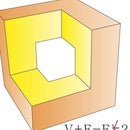Introduction: Need More Jack-o'-lanterns? Maybe Archimedes Will Help Us?
The Great Archimedes is ready to help us.
And it's great! According to legends, Archimedes created amazing structures to defend Syracuse's hometown in the battle with the Roman Empire.
The ancient Greek scientist Archimedes discovered 13 semi-regular polyhedra.
We will use three polyhedrons as a basis for creating Jack's Halloween lanterns:
- truncated cube;
- truncated octahedron;
- cuboctahedron.
Supplies
- 3 sheets of paper;
- scissors;
- glue;
- pen and ruler.
Step 1: Preparation.
The polyhedrons' size is chosen to fit into a sphere with a diameter of 100 mm.
This will allow us to create a collection of models of comparable sizes.
And most importantly, the polyhedron shape net will be able to fit on one A4 sheet.
Three more will be added to our collection to the two polyhedrons already created in the previous article.
To build, we need approximately 30 minutes of your time to create each polyhedron.
Step 2: Assembling the Cuboctahedron
For convenience, the fold lines can be drawn with a ballpoint pen.
This will make the fold lines more precise.
Cut the shape net with ordinary scissors along the contour.
Bend all the elements of the net along the fold lines.
The fold should be done inward.
The process of gluing the net is straightforward.
The petals are marked with numbers indicating the gluing sequence.
Step 3: Assembling the Truncated Cube.
For convenience, the fold lines can be drawn with a ballpoint pen.
This will make the fold lines more precise.
Cut the shape net with ordinary scissors along the contour.
Bend all the elements of the net along the fold lines.
The fold should be done inward.
The process of gluing the net is straightforward.
The petals are marked with numbers indicating the gluing sequence.
Step 4: Assembling the Truncated Octahedron
For convenience, the fold lines can be drawn with a ballpoint pen.
This will make the fold lines more precise.
Cut the shape net with ordinary scissors along the contour.
Bend all the elements of the net along the fold lines.
The fold should be done inward.
The process of gluing the net is straightforward.
The petals are marked with numbers indicating the gluing sequence.
Step 5: 13 Archimedean Polyhedra
The names of polyhedra are no longer as simple as those of the five Platonic solids.
Most likely, you will read the names for a long time.
But if you don't remember, then you can understand what we are talking about if we represent these polyhedra as a combination of polygons:
1. Truncated tetrahedron = 4 hexagons + 6 triangles
2. Truncated octahedron = 8 hexagons + 6 squares
3. Truncated icosahedron = 12 pentagons + 20 hexagons
4. Truncated cube = 6 octagons + 8 triangles
5. Truncated dodecahedron = 12 decagons + 20 triangles
6. Cuboctahedron = 8 triangles + 6 squares
7.Icosidodecahedron = 12 pentagons + 20 triangles
8.Great rhombicuboctahedron = 6 octagons + 8 hexagons + 12 squares
9. Truncated icosidodecahedron = 12 pentagons + 20 hexagons + 30 squares
10.Small rhombicuboctahedron = 18 squares + 8 triangles
11.Small rhombicosidodecahedron = 12 pentagons + 20 triangles + 30 squares
12. Snub cube = 6 squares + 32 triangles
13. Snub dodecahedron = 12 pentagons + 80 triangles
Maybe there is a ready-made kit so that I don't cut out the parts, but just glue it together?
Yes, there is such a set. Called Magic Edges 18, 19, 21, 27, 29, 32. It can be found on Amazon:
https://www.amazon.com/dp/B07FF3R1GB
Why exactly 13 polyhedra?
Some people have bad associations with this ominous number 13.
We have no answer to this question. Most likely, there were circumstances that exactly 13 polyhedra with such properties were discovered. Have there been any attempts to discover the 14th polyhedron with the same properties? Yes, many scientists have been looking for an answer. Some believe that the 14th polyhedron has been found. This is a Small rhombicuboctahedron with a rotated upper dome.
But if you remain a fan of the magic of the number 13, then you are unlikely to agree to such innovations.
To increase the effect, we publish this article 13 days before Halloween!
And 13 days after the publication of the previous article.
Happy Halloween!












